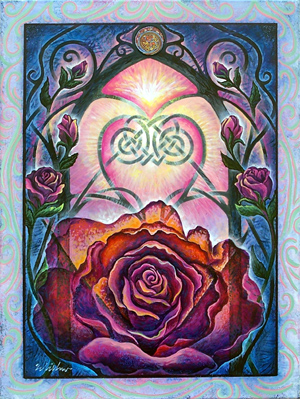“My Luve’s like a Red, Red Rose” (“My love is like a red red rose”) or “A Red Red Rose” is certainly the best-known song by Robert Burns , played invariably in scottish weddings, played by numerous artists from Celtic music and not.
Burns tells us that he reworked it from a song he heard during his travels in the Scottish countryside; in fact it belongs to the sea songs in which the sailor about to sail, greets his wife who stays at home waiting for him; a very popular theme of farewell, which has generated a whole series of songs like The Turtle Dove, Ten Thousand Miles , the same branch from which the bud of Robert Burns has spread.
ABOUT TUNES*
Burns initially gave his song to the Italian singer Pietro Urbani (1749-1816), who published it in his work “A Collection of Scots Songs” (1792-1804) with a melody composed by him, but at least three other melodies have been associated with; the text first was printed by James Johnson in The Scots Musical Museum, 1796 with the tune “Mary Queen of Scots” (Old Set) and then by George Thomson in Select Collection of Scottish Airs, 1799 with the tune ‘Wishaw’s favourite‘: Burns chose instead “Major Graham’s Strathspey “(a slow air by Neil Gow)
* http://burnsc21.glasgow.ac.uk/a-red-red-rose-2/

“My Luve’s like a Red, Red Rose” (“Il mio amore è una rossa, rosa rossa”) o “A Red Red Rose” è sicuramente la canzone più conosciuta di Robert Burns, suonata immancabilmente nei matrimoni, interpretata da numerosi artisti di area celtica e non.
Burns ci dice di averla rielaborata da una canzone sentita durante i suoi viaggi nella campagna scozzese; appartiene infatti al filone delle sea song in cui il marinaio in procinto di imbarcarsi saluta la moglie che resta a casa ad aspettarlo, un tema molto popolare quello dell’addio, che ha generato tutta una serie di canzoni come The Turtle Dove , Ten Thousand Miles, lo stesso ramo da cui è spuntata la gemma di Robert Burns.
Burns diede inizialmente la sua canzone al cantante italiano Pietro Urbani (1749-1816), che la pubblicò nel suo lavoro “A Collection of Scots Songs” (1792-1804) mettendoci una melodia di sua composizione, ma ancora altre tre melodie furono associate al testo prima dall’editore James Johnson (Scots Musical Museum, 1766 tune “Mary Queen of Scots“) e poi da George Thomson (Select Collection of Scottish Airs, 1799 tune ‘Wishaw’s favourite’): la melodia che Burns vi abbinò era “Major Graham’s Strathspey” (una slow air di Neil Gow)

Finally Robert Archibald Smith in his “Scottish Minstrel book” (1821) changed the melody with “Low Down in the Broom“, which became the standard one. An exhaustive study on this was made by Dr Kirsteen McCue ‘O My Luve’s Like a Red , Red Rose ‘: does Burns’s Melody Really Matter‘, in Studies in Scottish Literature 37 (2013)
Infine Robert Archibald Smith nel suo “Scottish Minstrel book” (1821) cambiò la melodia con “Low Down in the Broom“, che è diventata quella standard.
Uno studio esaustivo in merito è stato compiuto da Dr Kirsteen McCue ‘O My Luve’s Like a Red, Red Rose’: does Burns’s Melody Really Matter’, in Studies in Scottish Literature 37 (2013)

A LOVE DECLARATION
The song is a declaration of love that blends tenderness and arrogance, the lover to describe his love uses vivid images and metaphors: as a red rose, apparently a banality, but the phrase sung about the tune is of a such sweet and nd delicate beauty!
The rose has just blossomed, red as the fresh emotion of the first phases of love, a small fragile thing, destined to perish, but in the second verse this new love is compared to a melody, then to something more immaterial and more enduring, that cleverly played, it repays with an ever renewed sweetness.
Then the love for the girl becomes as big and deep as the sea and will be eternal, and hyperbolic with that image of the oceans that dry up and the rocks that melt with the sun! The last verse, the scene of the farewell, returns to the initial dimension: the poet must leave his little new love for a while, but he will return despite the distance that separates them (every rose has its thorn).
Il brano è una dichiarazione d’amore che fonde tenerezza e prepotenza, l’innamorato per descrivere il suo amore usa vivide immagini e metafore: a cominciare dalla rosa rossa, apparentemente una banalità, ma la frase cantata sulla melodia è di una bellezza dolce e delicata.
La rosa è appena sbocciata, rossa come l’emozione fresca delle prime fasi dell’amore, piccola fragile cosa, destinata a perire, ma nel secondo verso questo amore novello è paragonato ad una melodia, quindi a qualcosa di più immateriale e più duraturo, che abilmente suonata, ripaga con una sempre rinnovata dolcezza.
Poi l’amore per la fanciulla diventa grande e profondo come il mare e sarà eterno, e iperbolico con quell’immagine degli oceani che si prosciugano e delle rocce che si fondono con il sole!
L’ultima strofa la scena dell’addio riporta alla dimensione iniziale: il poeta deve abbandonare per poco il suo piccolo nuovo amore, ma ritornerà nonostante la distanza che li separa (ogni rosa ha la sua spina).
A Red Red Rose
[ Roud 12946 , V2890 ; Ballad Index FSWB140C ; Robert Burns]
O my Luve’s like a red, red rose (1)
That’s newly sprung in June;
O my Luve’s like the melodie
That’s sweetly play’d in tune.
As fair art thou, my bonnie lass,
So deep in luve am I:
And I will luve thee still, my dear,
Till a’ the seas gang dry:
Till a’ the seas gang dry, my dear,
And the rocks melt wi’ the sun (2):
I will luve thee still, my dear,
While the sands o’ life shall run.
And fare thee well, my only Luve
And fare thee well, a while!
And I will come again, my Luve,
Tho’ it were ten thousand mile (3)!
(1) In traditional ballads the rose is not just a rose but it is the symbol of amorous passion; the allusion to the most intimate and secret flower of women. So it appears in many warning songs
(2) in The Hornfair Garland published before 1780, there are lines similar to those in the third stanza:
The Day shall turn to Night, dear Love,
And the Rocks melt with the Sun,
Before that I prove false to thee…
(3) The Two Constant Lovers (c. 1690) has echoes of the fourth stanza:
Now I am gone away from thee,
Yet I’ll stay but a little while;
And I will come again to thee,
If that it was five hundred Mile.
Il mio amore è come una rossa, rosa rossa,
or ora sbocciata in giugno ;
il mio amore è la melodia
che si suona accordati in armonia.
Così bella tu sei, mia bella fanciulla,
che pazzo d’amore sono;
e sempre t’amerò, amor mio,
fino a quando s’asciugheranno tutti i mari;
fino a quando s’asciugheranno tutti i mari,
e si fonderanno le rocce al sole:
e sempre io t’amerò, amor mio,
finché scorrerà la sabbia della vita.
Addio, mio unico amore!
Addio per un momento!
Ritornerò, amore mio,
anche se sarò (3) a dieci mila miglia!
*Traduzione italiana di Cattia Salto parzialmente tratta da “Poemetti e canzoni” curata e tradotta da Adele Biagi, 1953 G. C. Sansoni – Editore – Firenze
(1) Nelle ballate popolari la rosa non è solo una rosa ma è il simbolo della passione amorosa; l’allusione al fiore più intimo e segreto della donna. Così compare in molte warning songs continua]
(3) ripassare un po’ di grammatica italiana non guasta, ci troviamo nel periodo ipotetico di tipo 1 in cui l’ipotesi è presentata come un fatto reale o comunque plausibile:
se+indicativo futuro + indicativo futuro
Jim Malcolm’s Bard Hair Day 2010: per il 250° compleanno di Robert Burns, Jim si è vestito da Bardo per tutti i suoi concerti del 2009. Dieci brani sono poi confluiti nel suo DVD

LINK
https://scholarcommons.sc.edu/ssl/vol37/iss1/8/
https://burnsc21.glasgow.ac.uk/a-red-red-rose/
http://burnsc21.glasgow.ac.uk/a-red-red-rose-2/
http://www.robertburns.org/works/444.shtml
https://mainlynorfolk.info/june.tabor/songs/myluveslikearedredrose.html
http://www.la-poesia.it/poesia-anglosassone/robert-burns-il-mio-amore-%C3%88-come-una-rosa-rossa-rossa-3285-1.html
